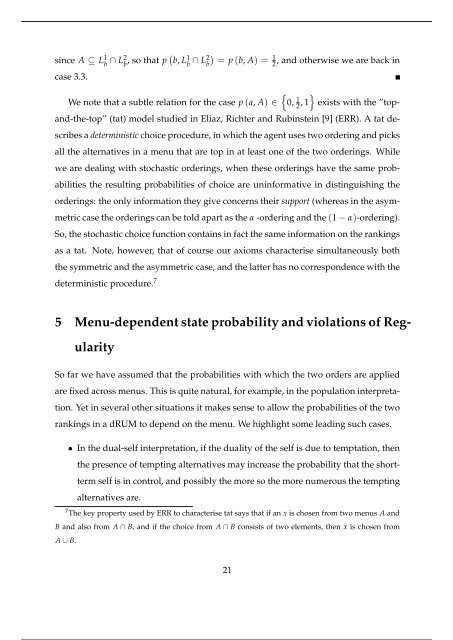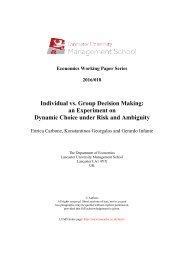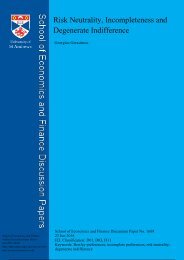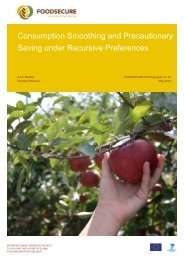Dual Random Utility Maximisation
n?u=RePEc:san:wpecon:1605&r=upt
n?u=RePEc:san:wpecon:1605&r=upt
Create successful ePaper yourself
Turn your PDF publications into a flip-book with our unique Google optimized e-Paper software.
since A ⊆ L 1 b ∩ L2 b , so that p ( b, L 1 b ∩ b) L2 = p (b, A) =<br />
1<br />
2<br />
, and otherwise we are back in<br />
case 3.3.<br />
}<br />
We note that a subtle relation for the case p (a, A) ∈<br />
{0,<br />
2 1, 1 exists with the ”topand-the-top”<br />
(tat) model studied in Eliaz, Richter and Rubinstein [9] (ERR). A tat describes<br />
a deterministic choice procedure, in which the agent uses two ordering and picks<br />
all the alternatives in a menu that are top in at least one of the two orderings. While<br />
we are dealing with stochastic orderings, when these orderings have the same probabilities<br />
the resulting probabilities of choice are uninformative in distinguishing the<br />
orderings: the only information they give concerns their support (whereas in the asymmetric<br />
case the orderings can be told apart as the α -ordering and the (1 − α)-ordering).<br />
So, the stochastic choice function contains in fact the same information on the rankings<br />
as a tat. Note, however, that of course our axioms characterise simultaneously both<br />
the symmetric and the asymmetric case, and the latter has no correspondence with the<br />
deterministic procedure. 7<br />
5 Menu-dependent state probability and violations of Regularity<br />
So far we have assumed that the probabilities with which the two orders are applied<br />
are fixed across menus. This is quite natural, for example, in the population interpretation.<br />
Yet in several other situations it makes sense to allow the probabilities of the two<br />
rankings in a dRUM to depend on the menu. We highlight some leading such cases.<br />
• In the dual-self interpretation, if the duality of the self is due to temptation, then<br />
the presence of tempting alternatives may increase the probability that the shortterm<br />
self is in control, and possibly the more so the more numerous the tempting<br />
alternatives are.<br />
7 The key property used by ERR to characterise tat says that if an x is chosen from two menus A and<br />
B and also from A ∩ B, and if the choice from A ∩ B consists of two elements, then x is chosen from<br />
A ∪ B.<br />
21






